PESTS AND DISEASES OF FORESTRY IN NEW ZEALAND
Nursery diseases
Scion is the leading provider of forest-related knowledge in New Zealand
Formerly known as the Forest Research Institute, Scion has been a leader in research relating to forest health for over 50 years. The Rotorua-based Crown Research Institute continues to provide science that will protect all forests from damage caused by insect pests, pathogens and weeds. The information presented below arises from these research activities.
Forest Pathology in New Zealand No. 16.
Based on Margaret Dick and AL Vanner (1986),
Revised by MA Dick (2008).
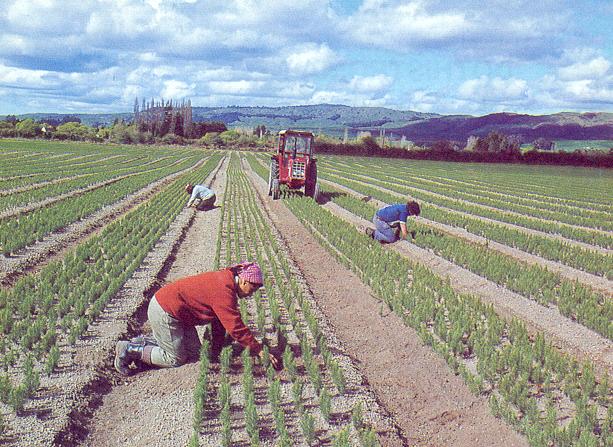
The production of healthy seedlings is a crucial step in the establishment of plantation forests. This leaflet describes fungal and bacterial diseases of nursery seedlings. The diseases are dealt with in the following order:
- Dothistroma needle blight
From Forest Pathology in New Zealand No. 16. Nursery diseases.
Based on Margaret Dick and AL Vanner (1986),
Revised by MA Dick (2008).Causal organism
Dothistroma septosporum (Dorog.) M. Morelet. Until 2004 there was only one species of Dothistroma known to cause needle blight of pines world wide but molecular analysis has indicated that there are two separate species, D. septosporum and D. pini Hulbary. The New Zealand population, which was called D. pini, is now recognised to be D. septosporum.
Type of injury
Death of needles.
Diagnostic features- Red bands appear on green needles, particularly near the base of the seedlings, and small, irregular, black, fruiting bodies can be found on the red bands (Fig. 1).
- Needles die and turn brown, and the bands become brick-red in colour.
- Dead needles may be shed from 2/0 stock.
Hosts
Larix decidua, Picea sitchensis, Pinus aristata, P. attenuata, P. ayacahuite, P. canariensis, P. contorta, P. coulteri, P. densiflora, P. elliottii, P. greggii, P. halepensis, P. hartwegii, P. jeffreyi, P. lambertiana, P. michoacana, P. montezumae, P. monticola, P. muricata, P. nigra, P. patula, P. pinaster, P. ponderosa, P. pseudostrobus. P. radiata, P. resinosa, P. roxburgii, P. sabiniana, P. serotina, P. strobus,. P. sylvestris, P. taeda, P. thunbergii, P. torreyana, Pseudotsuga menziesii.
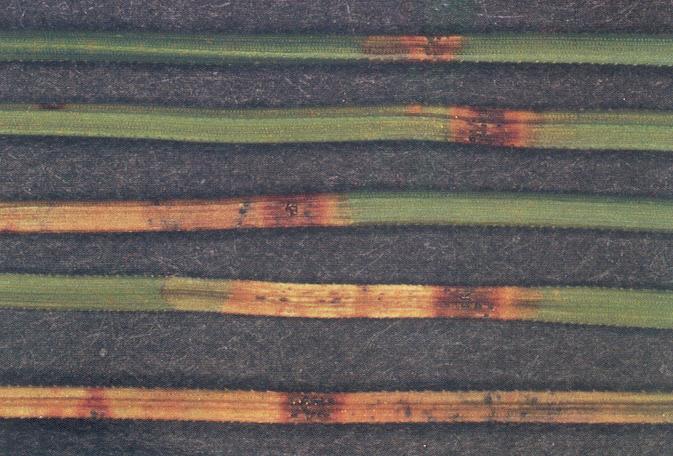
Fig. 1 - Pinus radiata needles with brick-red bands and black Dothistroma fruiting bodies.
Distribution
The disease has been recorded in nurseries in all parts of New Zealand.
Disease development
Seedlings become infected by fungal spores from Dothistroma fruiting bodies on diseased needles. The infection process may take place at any time after emergence of the seedlings, whenever environmental conditions are suitable. Spores originate from diseased trees outside the nursery, diseased seedlings growing in the nursery (particularly 2/0 seedlings which have been inadequately sprayed), or from infected plant debris carried into the nursery. The spores are liberated under wet conditions and distributed by water splash. Spores landing on a pine needle germinate and penetrate the needle through the stomata. The fungus then grows a few millimetres through the needle and produces a toxin called dothistromin which is responsible for the characteristic red bands. Soon after the appearance of the red band, fruiting bodies are produced which erupt through the surface of the needle. The period from the time of infection to the appearance of the red bands and fruiting bodies may vary from as little as 2 weeks to as long as 6 months, depending on environmental conditions. Once the disease signs have appeared, the infected needle usually dies and turns brown. Generally only the lower needles are affected (Fig. 2). If seedlings are left to over-winter in the nursery, infected needles may fall off.
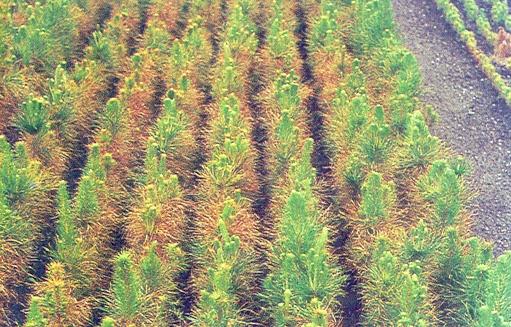
Fig. 2 – Pinus radiata seedlings with basal needles infected with Dothistroma pini.
Economic importance
Severely infected seedlings may become chlorotic and even die. However, disease levels of this magnitude are rarely encountered. Considerable defoliation may occur on 2/0 nursery stock which has been infected in the first growing season, particularly if prophylactic spraying has not been undertaken.
Control
Disease levels in nursery seedlings must be kept as low as possible to minimise the rate of disease build-up after planting out on the forest site.
Sound hygiene practices, such as the removal of old unwanted stock and removal of inoculum sources, are important.
Disease control is achieved by spraying with copper products; copper hydroxide, cuprous oxide or copper oxychloride. Frequency of application is related to environmental conditions. Where plants are at high risk of infection throughout the growing season spraying should commence on cuttings and seedlings in October or when seedlings are about 2 cm high, whichever is later, and continue monthly until the end of March. In other locations applications may not commence until mid-summer and subsequent applications will depend on rainfall. Apply 350-500 gm a.i. in 500 litres of water per hectare. For example: 1kg Kocide 2000 DS product or 1kg Copper oxychloride product per hectare, 1.25 l Champ Formular 2 Flowable (Kocide 2000 DS contains 350 g/kg copper; Copper oxychloride contains 500 g/kg copper; Champ Flow contains 334.5 g/l copper).
Because of the dense growth that develops in stool plants after cuttings have been taken achieving chemical penetration may be difficult. Hence some nursery managers may use a higher rate of copper on stool beds than on beds of seedlings or cuttings. For example: 2.5kg Kocide 2000 DS product in 500 litres of water per hectare
Note: In nurseries situated in cold areas, spraying with copper oxychloride under frosty conditions often results in browning and death of the lower needles of the seedling because of copper phytotoxicity. Copper hydroxide is also listed as a bacterial ice nucleation inhibitor and may therefore inhibit development of bacterial dieback in areas prone to the disease.
Bibliography
Bulman, L S; Gadgil, P D; Kershaw, D. J.; Ray, J. W. 2004: Assessment and control of Dothistroma needle-blight. Forest Research Bulletin No. 229, 48 p. - Terminal crook disease
From Forest Pathology in New Zealand No. 16. Nursery diseases.
Based on Margaret Dick and AL Vanner (1986),
Revised by MA Dick (2008).Causal organism
Colletotrichum acutatum Simmonds f. sp. pinea Dingley & Gilmour.
Type of injury
The terminal region of the stem of young seedlings grows around through 180 degrees, and its continued growth is suppressed.
Diagnostic features- Crook-shaped stem terminal which may become reddish. Terminals of developing laterals may also be deformed (Fig. 3).
- Some dead needles on the malformed terminal. In severe cases, all needles in this region die and the stem becomes necrotic. Pink, pustule-like fruiting bodies of the fungus may be visible on dead needles (Fig. 4).
- Stem becomes stiff with abnormal increase in diameter growth.
- Diseased seedlings shorter than uninfected seedlings.
Hosts
Pinus contorta P. elliottii,. P. muricata,. P. nigra,. P. pinaster, P. ponderosa, P. radiata.
Distribution
The disease has been recorded in the North Island and in Nelson.
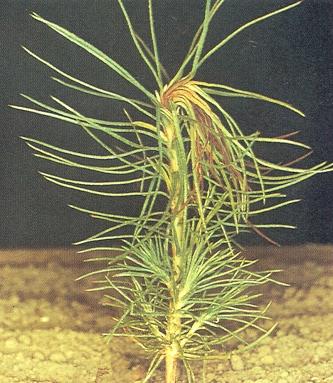
Fig. 3 -Pinus radiata seedlings showing the typical "terminal crook" symptom.
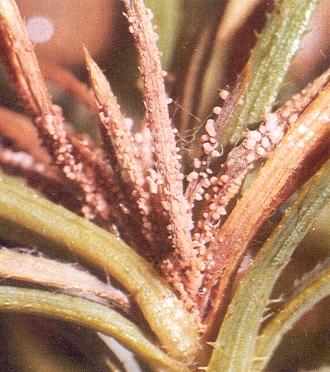
Fig. 4 - Pink pustules of the "terminal crook" fungus on infected needles of Pinus radiata.
Disease development
The disease mainly occurs in 1/0 stock, but 2/0 seedlings may sometimes be affected. There is no record of the disease developing in seedlings once they have been planted out on a forest site.
Infection occurs during warm, moist weather. Spores originate in infected soil debris and are dispersed by water splash. Those which land on the young needles on the seedling terminal germinate and penetrate the stem, which grows over into the typical crook shape. The infected needles in the terminal die and other needles in the apical shoot become yellow to light green in colour. The stem becomes much thicker and stiffer than normal and the malformed region of the stem may become reddish. If infection is severe, all the needles on the seedling terminal, and even the stem tissue, may die. This condition has been described as Terminal Blight. Under suitable environmental conditions, pink fruiting bodies develop on the dead needles and produce spores, which are distributed by water splash to nearby seedlings.
Affected seedlings remain in a dormant state until one of the upper lateral buds on the stem develops and grows into a dominant leader. This recovery may take place in the same growing season if the initial infection occurs very early in the growing season.
Economic importance
Under suitable climatic conditions large numbers of nursery seedlings can be affected in a very short time, and these seedlings must be discarded. The cost of prophylactic spraying is high.
Control
Where a nursery has no previous record of Terminal Crook disease, it is imperative that high standards of hygiene be maintained to prevent introduction of the disease. Tree stocks, soil, and machinery should not be introduced from nurseries in which the disease has been recorded.
Control can be achieved by applications of Sportak EW (450g/l prochloraz) at a rate of 1.5 l/ha at fortnightly intervals or 1.0 l/ha at weekly intervals in 500 litres of water per hectare.
This regime can be alternated with Shirlan (500g/l fluazinam) at a rate of 1.0 l/ha in 500 l water.
Spraying should be undertaken from seedling emergence until the end of March where there is high risk of disease. Some nurseries discontinue spraying during long periods of hot dry weather, where the disease risk is negligible
Overhead irrigation may create conditions suitable for disease development during dry weather.
Bibliography
Dick, M.A.; Vanner, A.L. 1986: Nursery diseases. New Zealand Forest Service, Forest Research Institute, Forest Pathology in New Zealand No. 16.
Dingley, J.M.; Gilmour, J.W. 1972: Colletotrichum acutatum Simmds. f.sp. pinea associated with "Terminal Crook" disease of Pinus spp. New Zealand Journal of Forestry Science 2:192-201.
Vanner, A.L.; Ray, J.W. 1977: Control of the disease "Terminal Crook" in pine seedlings. Fungicide and Nematicide Tests 32, Report No. 275.
Ray, J.W. 1975: "Terminal Crook" disease in pine nurseries. New Zealand Forest Service, Forest Research Institute, What's New in Forest Research No. 25. - Bacterial dieback
From Forest Pathology in New Zealand No. 16. Nursery diseases.
Based on Margaret Dick and AL Vanner (1986),
Revised by MA Dick (2008).Causal organism
Pseudomonas syringae p.v. syringae van Hall.
Type of injury
The stem of diseased seedlings is killed above the point of infection.
Diagnostic features- Wilting and death of stem above the point of infection, which is usually near the apex (Fig. 5).
- Affected stem often purplish.
- Affected stem dries out, becoming brown and brittle.
Hosts
Pinus muricata, P. patula, P. radiata.
Distribution
The disease has been recorded in many nurseries between Hamilton and lnvercargill.
Disease development
The disease appears in autumn, generally when frosts follow a period of rain. A translucent lesion appears on the stem at the point of infection, usually in the soft regions of the stem near the terminal. The stem may become purplish as it wilts above the point of infection. The collapsed tissue then dies, becoming brown and brittle. If seedlings are left to grow on as 2/0 stock, either one lateral bud will develop into a dominant leader or several will develop into multi-leaders.
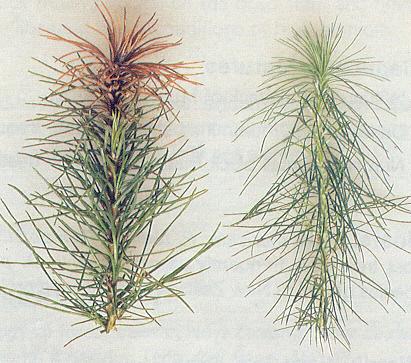
Fig. 5 – Pinus radiata seedlings with apical portion killed by Pseudomonas syringae on left. Healthy seedling on right.
Economic importance
Bacterial dieback is of little economic importance as it usually occurs in small isolated patches. However, one instance has been reported where over 20% of seedlings in a 0.8-ha block were affected by the disease.
Control
Control is not usually necessary as the disease occurs rarely, and usually in isolated patches. Antibiotic preparations containing streptomycin that were used in the past are no longer available but applications of copper products (350-500 gm a.i. copper hydroxide or copper oxychloride in 500 litres of water per hectare) have been demonstrated to reduce disease incidence.
Bibliography
Langridge, Y.N.; Dye, D.W. 1982: A bacterial disease of Pinus radiata seedlings caused by Pseudomonas syringae. New Zealand Journal of Agricultural Research 25: 273-276. - Diplodia dieback
From Forest Pathology in New Zealand No. 16. Nursery diseases.
Based on Margaret Dick and AL Vanner (1986),
Revised by MA Dick (2008).Causal organism
Sphaeropsis sapinea (Fries) Dyko & Sutton (= Diplodia pinea (Desmazieres) Kickx)
Type of injury
Shoot death.
Diagnostic features- Wilting and dieback of buds and shoots.
- Dead, brown, mummified stems (Fig. 6), frequently bent over.
- Numerous small black fruiting bodies on dead tissue.
Hosts
Pinus contorta, P. muricata, P. ponderosa, P. radiata;. Pseudotsuga menziesii. Pinus radiata is the host tree most frequently associated with S. sapinea dieback. However, all pine species grown in New Zealand nurseries are probably susceptible to some degree.
Distribution
Throughout New Zealand.
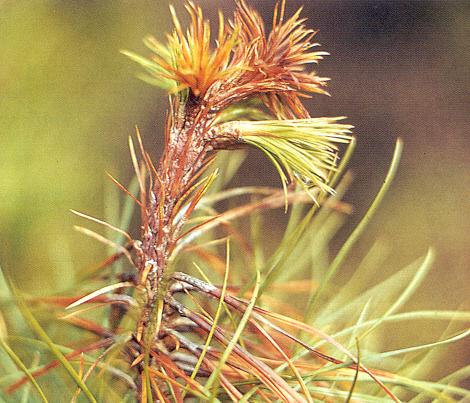
Fig. 6 – Dead brown tip of Pinus radiata infected with Sphaeropsis sapinea.
Disease development
In the nursery, S. sapinea is generally considered to be a wound parasite, infecting tissue that has already begun to wilt through other causes such as drought or being wrenched in dry weather. It may also infect tissue which has been physically or chemically injured. Infection occurs when spores, which are spread by water splash, land on susceptible tissue, germinate, and penetrate the host epidermis. Once infection is established, most seedlings show considerable resistance to continued invasion of the tissue and the fungus spreads only a short distance in the stem.
The soft tissue of the stem just below the leading shoot is the point commonly attacked. During the early stage of development, the stem may be purplish around the point of infection. The shoot then wilts above this point, turns brown, and crooks over. Numerous small black fruiting bodies on the dead stem and needle tissue produce spores, which are liberated under moist conditions.
Economic importance
Although this disease seldom causes mortality, seedling height is reduced. Loss of the leading shoot can occur more than once and this may lead to a stunted bushy plant which is usually not plantable.
Control
Not considered necessary.
Bibliography
Gilmour, J.W. 1966: The pathology of forest trees in New Zealand. New Zealand Forest Service, Forest Research Institute, Technical Paper No. 48. - Cypress canker
From Forest Pathology in New Zealand No. 16. Nursery diseases.
Based on Margaret Dick and AL Vanner (1986),
Revised by MA Dick (2008).Causal organisms: Seiridium cupressi (Guba) Boesewinkel (Lepteutypa cupressi (Nattrass, C. Booth, & B. Sutton) H.J. Swart; in this country previously called Seiridium unicorne (Cooke & Ellis) B. Sutton = Monochaetia unicornis (Cooke & Ellis) Saccardo).
Seiridium cardinale (W.W. Wagener) B. Sutton & I.A.S. Gibson (= Coryneum cardinale W.W. Wagener).
Type of injury
Branch death, or mortality of seedlings if infection occurs low on the stem.
Diagnostic features- Resinous areas, often swollen, on stems and branches, that may develop into cankers (Fig. 7).
- Dieback of terminal and lateral shoots.
Hosts
Chamaecyparis lawsoniana‡, Cryptomeria japonica*, × Cupressocyparis leylandii‡, × Cupressocyparis ovensii†, Cupressus arizonica†, Cupressus goveniana†, Cupressus lusitanica†, Cupressus macrocarpa§, Cupressus sempervirens‡, Cupressus torulosa†, Calocedrus decurrens†, Juniperus communis*, Sequoiadendron giganteum*, Thuja occidentalis†, Thuja plicata.
*Rare occurrence with negligible damage.
†Low susceptibility.
‡Moderate susceptibility (for C. sempervirens, based on overseas reports).
§Very susceptible, especially in young plantations less than 10 years old.
Distribution
Seiridium cupressi is more common than S. cardinale, though both fungi are found throughout New Zealand. The incidence and impact of the disease intensify as the mean temperature increases, making it more prominent in Northland and Auckland.
Disease development
This disease is unusual in that two different fungi cause identical symptons. Initial infection by these fungi commonly occurs at the base of a branchlet, though it may occur through wounds on any part of the seedling. The infected tissue turns brown, and large amounts of resin are exuded. Fading and death of foliage follows girdling of the affected branches. Small black pustules, in which the spores are produced, appear on the surface of the dead tissue. Spores are spread by water splash. Diseased trees neighbouring the nursery are the most usual source of initial inoculum.
Economic importance
Generally, the disease is of little importance in nurseries. However, if there is a nearby inoculum source widespread infection may occur, leading to considerable damage
Alternatively, infected seedlings may not develop severe cankering until they are planted out in the field.
see Cypress Canker: Forest Pathology in New Zealand No. 8:
Control
Good control has been obtained overseas by monthly spraying in spring and summer with 4kg of Copper Oxychloride 50WP (500g/kg copper oxychloride) and 10 litres of surfactant in 1000 litres of water per hectare. In New Zealand copper is applied at a lower rate e.g. 1kg Copper Oxychloride 50WP in 500 titres of water per hectare.
Removal of infected seedlings is the best means of checking the disease. Strict nursery hygiene should be practised and all infected material burnt. Cypress trees close to the nursery should be examined for infection and infected trees removed if the nursery intends to continue producing cypress stock.
As a precaution against planting out diseased stock, trees should be examined before leaving the nursery so that any trees with symptoms of cypress canker can be destroyed.
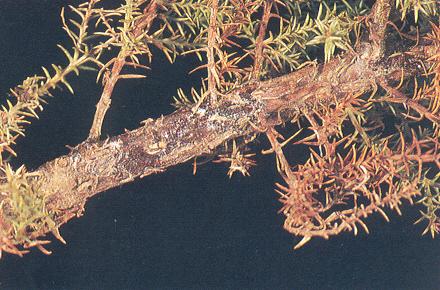
Fig. 7 – Resinous exudate on stem of Cypressus macrocarpa seedling infected with Seiridium cupressi
Bibliography
Hood, I.A.; Gardner, J.F.; Kimberley, M.O.; Gatenby, S.J.; Cox, J.C. 2001: A survey of cypress canker disease. New Zealand Tree Grower 22: 38-41.
Van der Werff, H. 1984: Cypress canker in New Zealand plantations. New Zealand Journal of Forestry Science 18: 101-108. - Mycosphaerella leaf-blotch
From Forest Pathology in New Zealand No. 16. Nursery diseases.
Based on Margaret Dick and AL Vanner (1986),
Revised by MA Dick (2008).Causal organism
Mycosphaerella cryptica (Cooke) Hansford.
Type of injury
Leafspot and shoot dieback.
Diagnostic features- Reddish brown, irregular-shaped spots with a purple margin on both sides of young leaves. Spots eventually turn dark grey (Fig. 8).
- Holes in leaves.
- Infected leaves often distorted.
- Shoot death.
Hosts
Eucalyptus delegatensis, E. fastigata, E. regnans.
Distribution
All of the North Island south of Whangarei and the northern half of the South Island.
Disease development
Leafspots are circular to irregular in shape, and red- brown with a distinctive purple margin when young, turning dark grey later. Eventually, the dead tissue drops out leaving the leaf riddled with holes. Leaves may become badly distorted and those with extensive infection are readily cast. When the attack occurs on a young shoot, the fungus frequently girdles the shoot causing dieback above that point.
Fruiting bodies of the asexual state of the fungus occur from December to March, and spores are splash-dispersed by water. The sexual state, with its wind- dispersed spores, is present throughout the year. Infection is initiated when spores land on susceptible tissue, germinate, and penetrate the host tissue. Young expanding leaves and shoots are susceptible and infection can occur from spring through to autumn. Optimum temperatures for infection are 18-24oC.
Economic importance
Generally, the disease is of significance only on E. delegatensis seedlings. The disease is usually confined to nurseries where there is an inoculum source nearby, such as a stand of diseased E. delegatensis.
Control
Control can be achieved by fortnightly applications of chlorothalonil e.g. 2l Bravo Weatherstik (500g/l of chlorothalonil), and 0.33 litres of wetting agent in 1000 litres of water per hectare.
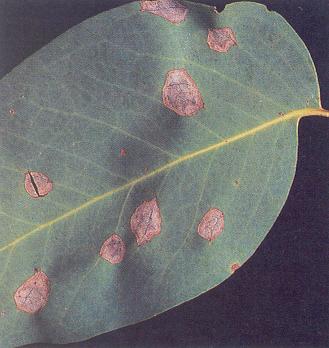
Fig. 8 – Leaf lesions on Eucalyptus delegatensis caused by Mycosphaerella cryptica.
Bibliography
Dick, M. 1982: Leaf-inhabiting fungi of eucalypts in New Zealand. New Zealand Journal of Forestry Science 12: 525-537.
Dick, M.; Gadgil, P.D. 1983: Eucalyptus leafspots. New Zealand Forest Service, Forest Research Institute, Forest Pathology in New Zealand No. 1.
Dick, M.A.; Vanner, A.L. 1986: Nursery diseases. New Zealand Forest Service, Forest Research Institute, Forest Pathology in New Zealand No. 16. - Grey mould
From Forest Pathology in New Zealand No. 16. Nursery diseases.
Based on Margaret Dick and AL Vanner (1986),
Revised by MA Dick (2008).Causal organism
Botrytis cinerea Persoon ex Fries
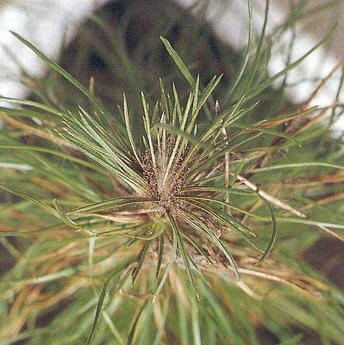
Fig. 9 – Fungal strands and grey powdery fruiting bodies of Botrytis cinerea on the infected tip of a Pinus radiata seedling.
Type of injury
Dieback and occasional mortality.
Diagnostic features- Death of leaves, needles, and succulent branches and stems.
- Sparse webbing of grey fungal strands on affected parts of the plant (Fig. 9).
- Shoot dieback.
- Grey, powdery appearance of dead tissues.
Hosts
Botrytis cinerea has a wide host range on broadleaved trees and conifers. Undoubtedly, there are many more susceptible hosts grown in forest nurseries than those recorded so far in New Zealand. Araucaria araucana, Cryptomeria japonica, Cupressus macrocarpa, Eucalyptus botryoides, E. delegatensis, E. maidenii, E. ovata,. E. saligna, Pinus brutia, P. muricata, P. nigra, P. radiata, Pseudotsuga rnenziesii, Sequoia sempervirens, Thuja plicata.
Distribution
Throughout New Zealand.
Disease development
Though B. cinerea can invade healthy tissues, it more commonly behaves as a wound parasite, first becoming established on dead or moribund tissue and then spreading into adjacent healthy tissue, where it causes a soft rot of leaves, succulent stems, and branches. The fungus is widely present on dead and dying plant material so that spores are readily available when conditions become suitable for infection. High humidity and moderate temperatures (12-20oC) are ideal for infection. If humidity remains high, infected plants rapidly become covered with a grey mould - the spores and spore-bearing structures of the fungus. The spores are dispersed by air currents and germinate quickly on contact with susceptible host tissue.
Economic importance
Although common and widespread, B. cinerea seldom causes significant losses.
Control
Apply Thiram at a rate of 3.400 kg a.i./ha in 500 to 1 000 litres of water per hectare. E.g. Thiram 40F (400g/l thiram) at a rate of 8.5 l /ha, or Thiram DF (800g/kg thiram) at a rate of 4.25 kg/ha.
Captan products provide control at a rate of approximately 1100g a.i. in 500 to 1,000 litres of water per hectare. E.g. Captan 8OW or (Merpan 800g/kg captan) at a rate of 1.4kg/ha.
Bibliography
Gadgil, P.D. 2005: Fungi on trees and shrubs in New Zealand. Fungi of New Zealand Volume 4. Fungal Diversity Research Series 16: 1-437.
Gilmour, J.W. 1966: The pathology of forest trees in New Zealand. New Zealand Forest Service, Forest Research Institute, Technical Paper No. 48. - Damping-off
From Forest Pathology in New Zealand No. 16. Nursery diseases.
Based on Margaret Dick and AL Vanner (1986),
Revised by MA Dick (2008).Causal organisms
Many soil-inhabiting fungi have been associated with damping-off. In New Zealand the most important are:
Cylindrocladium scoparium Morgan,
Fusarium spp.,
Phytophthora spp.,
Pythium spp.,
Rhizoctonia solani Kuhn
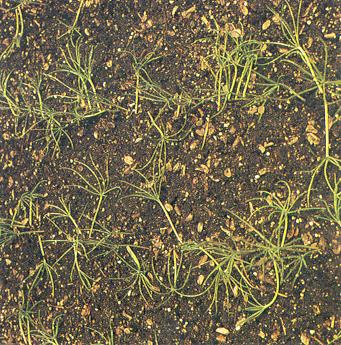
Fig. 10 – Small Pinus radiata seedlings with collapse of the succulent stem caused by Phytophthora sp.
Type of injury
Seedling mortality.
Diagnostic features- Bare spaces in nursery beds.
- Small seedlings lying on the ground after collapse of succulent stems (Fig. 10).
Hosts
Small seedlings of all plants are susceptible to attack by damping-off fungi.
Distribution
Throughout New Zealand.
Disease development
All the tissues of very young seedlings are susceptible to infection by non-specific parasites. These diseases are more prevalent in moist soils and wet weather, hence the name "damping-off". There are two types of damping-off:
(a) Pre-emergence damping-off is recognised by bare spaces in the rows of seedlings caused by some germinating seeds rotting before they break through the soil. Though a sparse crop may be due to low viability of seed, it is more frequently a result of soil fungi attacking the germinating seeds.
(b) Post-emergence damping off is the collapse and withering of seedlings soon after they have emerged from the soil. This may be due to fungal attack on the stem or roots or both.
Damping-off fungi grow freely from the diseased tissue back into the soil. All damping-off fungi normally live on dead plant material in the soil and their continued development is enhanced by the nutrient supply provided by the dead seedlings.
Cylindrocladium scoparium has been recorded less frequently in forest nurseries than the other damping-off pathogens, but can cause significant losses. In addition to below-ground attack, C. scoparium may also attack the succulent stem or first leaves. This occurs under conditions of high humidity following excessive rain (or over-watering), and there may be rapid spread of the fungus from seedling to seedling. Spores may be produced on the dead stems giving a powdery appearance to the host. When environmental conditions are unfavourable for growth, sclerotia (small dense masses of fungal tissue) are formed and these remain dormant in the soil until conditions improve.
Infection by Fusarium species can occur over a wide soil moisture range, but the optimum soil temperature is between 20 and 30oC, which is generally higher than for other damping-off fungi. Thick-walled spores (chlamydospores) are formed under adverse environmental conditions and remain dormant in the soil until conditions are suitable for germination.
Phytophthora and Pythium species are closely related and are generally considered to be the most destructive and the most prevalent of the damping-off micro-organisms. Infection occurs when the spores come in contact with susceptible root tissue, germinate, and penetrate the root wall. As the spores are mobile, moving free in soil water between the soil particles, high soil moisture content is needed for spore release and dispersal.
As Rhizoctonia solani is strongly aerobic, attack by this fungus is generally confined to the upper 1.5 cm of soil and to stems in the saturated air just above the soil. Abundant soil moisture inhibits the activity of this fungus in the soil, although at these times it may grow over the soil surface attacking emerging seedlings. Rhizoctonia does not produce spores but forms abundant sclerotia. In very acid soils, R. solani tends to predominate over other damping-off fungi.
Economic importance
Pre-emergence losses from fungal attack are difficult to assess because the damage is hidden, and poor germination may result from other causes. Even the effects of post-emergence damping-off may be confused with those caused by other damaging agencies, such as sun scorch, frost, or drought. No seedling can be regarded as resistant to damping-off but those that germinate quickly and grow fast are less likely to be affected.
Given the appropriate environmental conditions, losses resulting from damping- off can be extremely high.
Control
Damping-off diseases are best kept in check by following sound nursery practices. Damping-off is less likely to occur where seedlings are not placed under stress. Stratification of seed ensures even germination and reduces the period of time over which the crop is susceptible. Where chemical control of the disease is considered desirable, the following treatments have been shown to give good results.
Pre-sowing application of Terrazole 35wp (350g/kg etridiazole) at a rate of 130kg/ha followed by rotary hoeing to a depth of 15cm. This fungicide is effective against species of Phytophthora and Pythium.
Pre-sowing application of Basamid Granular (970g/kg dazomet) at a rate of 500kg/ha followed by rotary hoeing to a depth of 15cm. This chemical is a soil ‘sterilant’ and kills a wide range of fungal species and soil organisms including nematodes. Germination trials with cress seed need to be undertaken prior to seed sowing to ensure that complete dissipation of the chemical has occurred.
A pre-emergence application of metalaxyl (available as Ridomil products) at a rate of 1-4 kg/ha a.i. in 200-300 litres of water per hectare has been recommended. Where possible, apply to damp ground. Use the higher rate for soils with a high organic content and on beds with a previous history of root rot problems. The half-life of metalaxyl is strongly influenced by soil type and has been reported to range from 82 days to less than one day. Furthermore, degradation of metalaxyl can be accelerated in soils with a history of metalaxyl usage. About 10 mm of rain or irrigation is required to move the fungicide into the soil.
A post-emergence drench of captan at a rate of 1.2 kg/ha a.i. in 500 to 1,000 litres of water per hectare has been recommended for controlling damping off in forest nurseries. E.g. Captan 8OW or (Merpan 800g/kg captan) at a rate of 1.4kg/ha.
Monthly applications of phosphorous acid (e.g. Foli-R-Fos, Foschek) at a rate of 2.6 kg/ha a.i. from December, or fortnightly from February gave good control of Phytophthora root disease in a recent trial.
Seed treatment prior to sowing with a fungicide such as Aliette WG (800 g/kg fosetyl aluminium), Aliette Super (528g/kg fosetyl aluminium. 172g/kg thiram. 129g/kg thiabendazole), Thiram, Apron C70 SD (350g/kg metalaxyl, 350g/kg captan), or Captan 80W may control damping-off. These fungicides have been recommended for use as seed dressings to control damping off fungi on seed of other crops.
Bibliography
Bassett, C. 1961: Some soil-borne fungi in forest nurseries. New Zealand Science Review 19: 24.
Phillips, D.H.; Burdekin, D.A. 1982: "Diseases of forests and ornamental trees." Macmillan Press Ltd. Pp. 52-55. - Root and collar rot
From Forest Pathology in New Zealand No. 16. Nursery diseases.
Based on Margaret Dick and AL Vanner (1986),
Revised by MA Dick (2008).Causal organisms
Fungi which cause damping-off can also be responsible for root and collar rot.
Type of injury
Growth reduction; mortality in severe cases.
Diagnostic features- Flattened or depressed resinous areas on the lower stem.
- Pale, faded foliage.
- Wilting of woody seedlings.
- Mortality, frequently in irregular patches but occasionally widely scattered. (Fig. 11).
- Brown, rotten roots and lower stem.
Hosts
All species of seedlings are susceptible to attack of root tips by non- specific parasitic soil organisms.
Distribution
Throughout New Zealand.
Disease development
The organisms which have the potential to cause seedling root-rot disorders commonly live in the soil on dead vegetable material. They attack seedlings and cause mortality under conditions which place the seedlings under stress but do not severely restrict fungal growth and spread.
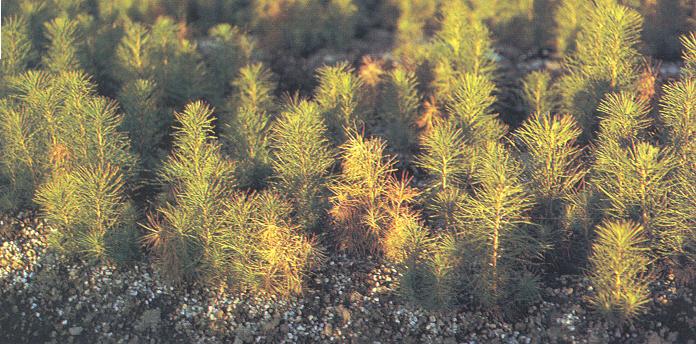
Fig. 11 – Root-rot induced mortality in a Pinus radiata nursery bed.
Cylindrocladium scoparium may infect both developing roots and the lower stem. Conditions for growth and development of this fungus are as described for "Damping-off".
Root infection by Fusarium spp. takes place under conditions as described for "Damping-off". Generally, the root-invading species of Fusarium are warm soil organisms. Fusarium solani has been consistently associated with resinous lesions at the root collar of Psuedotsuga menziesii (Douglas fir) seedlings which have been damaged at ground level by hot soils. If the stem is girdled, mortality rapidly follows.
Conditions for the growth and spread of Phytophthora and Pythium species are as described for "Damping-off". Phytophthora spp., are destructive pathogens causing rots of roots, the root crown and sometimes the lower stem and a number of species have ben recorded in forest nurseries. Waterlogged soils provide a suitable environment for infection as the motile spores require free water for spore release and dispersal. Once roots are infected disease levels may be intensified by dry conditions which place the plants under stress. Phytophthora cinnamomi Rands is the species most frequently recorded in forest nurseries, infecting a wide range of host species and responsible for substantial losses. It is widespread and has been recorded in nurseries from the far north of the North Island to the south of the South Island. Phytophthora cactorum (Lebert & Cohn) J. Schröt. has been associated with losses in some nurseries. Losses at Milton Nursery which was established in 1946 on a heavy clay soil with slow natural drainage and high water holding capacity were attributed to P. cactorum. Although a great deal was done to alleviate the water-logging low-lying parts of the nursery continued to flood after heavy rain and it was finally closed in the late 1970s with the recognition that losses to disease were likely to continue at unsustainable levels. In some nurseries seedling mortality due to Phytophthora infection does not become apparent until root pruning commences in late summer/early autumn. It is likely that root systems are already infected.
As Rhizoctonia solani is generally confined to the upper layer of soil, initial attack is at the base of the stem or at the root crown. Small, brownish sclerotia may sometimes be formed on the lower stem of infected seedlings and are then clearly visible scattered over the tissue.
Economic importance
Root rot differs from damping-off in that it attacks the root tips of older seedlings. It usually results in restricted growth rather than death because even when most of the original root system has been destroyed, new roots will develop if soil moisture conditions are favourable. However, if root damage has been extensive and a drought or excessively wet soil conditions occur, both of which discourage the formation of fresh roots, even quite large seedlings may die.
Seedling collapse can also occur when there is fungal attack of the stem at ground-level, usually following injury to the stem tissues by insects, soil abrasion, or sun scorch.
Control
The options available for the control of root and collar rot are the same as those described for "Damping-off".
Bibliography
Bassett, C 1961: Some soil-borne fungi in forest nurseries. New Zealand Science Review 19: 24.
Phillips, DH; Burdekin, D.A. 1982: "Diseases of forest and ornamental trees". Macmillan Press Ltd. Pp. 52-55.
Reglinski, T; Spiers, TM; Dick, MA; Taylor JT; Gardner JF 2008: Management of Phytophthora in bare-rooted radiata pine seedlings. In press. - Minor diseases: Swiss needle-cast and Phomopsis dieback
From Forest Pathology in New Zealand No. 16. Nursery diseases.
Based on Margaret Dick and AL Vanner (1986),
Revised by MA Dick (2008).The following diseases are of infrequent occurrence in forest nurseries and do not cause significant damage. No control is considered necessary.
Swiss needle-cast
Phaeocryptopus gaeumannii (Rohde) Petrak may cause premature casting of Pseudotsuga menziesii needles aged 1 year or more.
In a trial on two year old potted seedlings. Copper Oxychloride 50WP (500glkg copper oxychloride) at 0.25g/litre plus surfactant at 1 ml/l gave good control.
Phomopsis dieback
Phomopsis juniperovora Hahn causes flagging of branches and dieback of Cupressus macrocarpa.
The fungicides, thiophanate (e.g. Topsin M-4A) and mancozeb (e.g.Manacozeb, Manex II) have given control of Phomopsis in trials overseas. Treatment for Phomopsis tip blight should begin in early spring and continue at 10-14 day intervals if conditions are conducive to disease development.
Bibliography
Gilmour, J.W. 1966: The pathology of forest trees in New Zealand. New Zealand Forest Service, Forest Research Institute, Technical Paper No. 48.
Hood, I.A. 1983: Swiss needle-cast in Douglas fir. New Zealand Forest Service, Forest Research Institute, Forest Pathology in New Zealand No. 2.
Hood, I.A.; Sandberg, C.J. 1985: Some minor fungi of conifers (Phomopsis pseudotsugae, P. juniperovora, and Rhizosphaera kalkhoffii). New Zealand Forest Service, Forest Research Institute, Forest Pathology in New Zealand No. 13.
Brand names appearing in this publication are for product identification purposes only. No endorsement is intended, nor is criticism implied of similar products not mentioned.
This information is intended for general interest only. It is not intended to be a substitute for specific specialist advice on any matter and should not be relied on for that purpose. Scion will not be liable for any direct, indirect, incidental, special, consequential or exemplary damages, loss of profits, or any other intangible losses that result from using the information provided on this site.
(Scion is the trading name of the New Zealand Forest Research Institute Limited.)

 Farm Forestry New Zealand
Farm Forestry New Zealand

